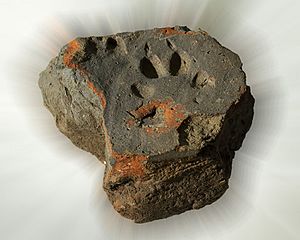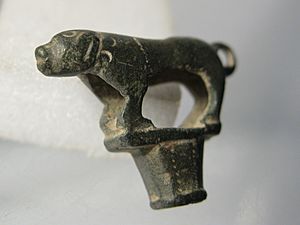Dogs of Roman Britain facts for kids
Dogs were important animals in Roman Britain, which was the part of Britain controlled by the Roman Empire. We know this from things found by archaeologists. They have discovered dog bones, small statues of dogs, and signs that dogs were used in religion. Old Roman writings also mention how dogs were used.
The Roman province of Britannia was famous for its dogs. Roman writers said that British dogs were fast and strong. They were good for hunting and even for war. Some people think these dogs were a special breed. They might have been the ancestors of the English Mastiff and possibly the Bulldog.
Contents
Dogs in Roman Culture
Dogs were often seen as special animals in Roman times. They were sometimes shown with gods and goddesses.
Dogs and Roman Gods
The goddess Nehalennia was sometimes shown with a small dog. She was important for protecting traders who sailed to Britain. People think her dog might have looked like a greyhound or a Welsh Springer Spaniel.
The Agassian Dog
An ancient writer named Oppian wrote about a special British hunting dog. He called it the "Agassian." He said these dogs were small but very good at hunting. They were known for their amazing sense of smell. They could track animals on the ground and even smell scents in the air!
Another god, Sucellus, was also shown with a dog. This dog often represented a connection to the underworld.
Dogs and Funerary Practices
Dogs were also linked to beliefs about death. Because dogs were thought to have a connection to the underworld, people sometimes placed dog statues with the dead. They believed this helped souls on their journey.
Dogs and Healing
Romans also thought dogs had healing powers. They believed dogs only got a few illnesses like gout or rabies. So, puppies were sometimes used to "take away" pain from sick people.
Hunting Dogs of Britain
British hunting dogs were highly valued. Even though they also helped with herding and guarding, they were considered better hunters than the Molossus dogs from Greece. The writer Strabo described British hunting dogs as very smart. He also wrote that these hunting dogs were a main export from Britain because of their high quality.
Dogs as Personal Animals
Scientists who study animal bones (called zooarchaeologists) have found proof that people in Roman Britain owned dogs. We can see that humans cared for these dogs by looking at their bones.
For example, at one site in France, a dog's remains showed serious dental problems. It had lost teeth and had a lot of plaque. This dog would have needed human help to eat. This suggests that dogs were well cared for.
It's important to remember that the word "pet" might not be quite right for Roman times. Back then, working animals and "pets" were often the same. So, some experts suggest using the term "personal animal" instead. This better describes the role of dogs in Roman Britain.
Dogs and the Roman Economy
Roman Britain didn't have as many resources as other Roman areas. But its excellent dog breeds became a very important export. They were a big part of trade. The most popular British dog breeds mentioned by Roman writers included the Irish wolfhound, the English Mastiff, and the Agassian. Besides being companions, dog products like meat and hides were also part of Roman Britain's economy.
Dogs in Roman Art
The strong connection between Britain and its hunting dogs was so famous that Roman art often showed hunting scenes with British dogs.
Small dog statues were found at a place called Southbroom. Some had long tongues, while others showed a dog holding a human. These differences might show how dogs changed from wild predators to tamed animals. It's also interesting that the dog figures were always larger than the humans. This might mean the dogs were seen as gods or divine protectors. This idea fits with dogs being linked to the underworld.



